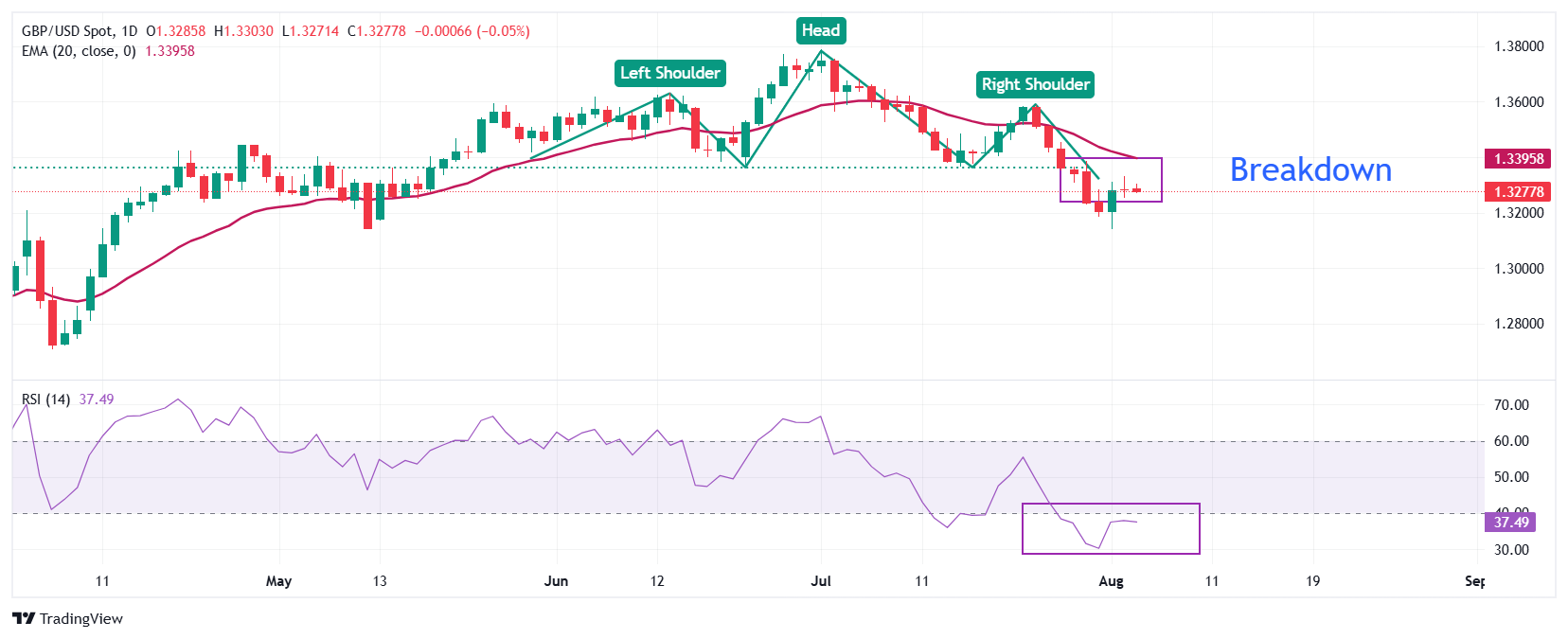Pound Sterling flattens as investors shift focus to upcoming BoE monetary policy decision

- The Pound Sterling trades steady, while investors shift their focus to the BoE’s interest rate decision on Thursday.
- Investors expect the BoE to reduce interest rates by 25 basis points to 4%.
- Traders are now almost fully pricing in a Fed interest rate cut in September.
The Pound Sterling (GBP) trades broadly flat against its major peers on Tuesday as investors shift their focus to the Bank of England’s (BoE) monetary policy announcement on Thursday.
Investors expect the BoE to cut interest rates by 25 basis points (bps) to 4%. This would be the fifth interest rate cut by the United Kingdom (UK) central bank in its current monetary expansion cycle, which started in August 2024.
Market participants will pay close attention to the monetary policy statement and the BoE Governor Andrew Bailey’s press conference to get cues about the likely monetary policy action by the central bank in the remainder of the year. In the June monetary policy announcement, the BoE guided a “gradual and cautious” monetary policy expansion.
A slowdown in labor demand and an increase in inflationary pressures have led to rising fears of stagflation in the UK economy.
Lately, labor market indicators have signaled that firms are reluctant to increase their workforces due to an increase in employers’ contributions to social security schemes. Meanwhile, the Consumer Price Index (CPI) report for June showed that both headline and core inflation rose faster than expected.
Daily digest market movers: Pound Sterling consolidates
- The Pound Sterling oscillates in a tight range around 1.3280 against the US Dollar (USD) during the European trading session on Tuesday. The GBP/USD pair consolidates, while the US Dollar trades broadly stable ahead of the United States (US) revised S&P Global PMI data and the ISM Services Purchasing Managers’ Index (PMI) data for July, which will be published during North American trading hours.
- The US Dollar Index (DXY), which tracks the Greenback’s value against six major currencies, stabilizes around 98.80 after a sharp decline on Friday.
- Economists expect the ISM Services PMI to come in at 51.5, higher than the 50.8 reading seen in June, suggesting that the service sector activity grew at a faster pace. Investors will closely monitor the data as the services sector accounts for around two-thirds of the US economy.
- Meanwhile, the outlook of the US Dollar has become uncertain as traders have raised bets supporting interest rate cuts by the Federal Reserve (Fed) in the September policy meeting. According to the CME FedWatch tool, the probability of the Fed cutting interest rates in the September meeting has increased to 92.2% from 41.2% seen on Thursday, a day before the release of the Nonfarm Payrolls (NFP) data for July.
- On Friday, the NFP report showed signs of a sharp slowdown in hiring levels and an increase in the Unemployment Rate.
Technical Analysis: Pound Sterling wobbles around 1.3300

The Pound Sterling trades quietly below 1.3300 against the US Dollar on Tuesday. The outlook of the pair remains bearish as the breakdown of the Head and Shoulders (H&S) chart pattern holds and the 20-day Exponential Moving Average (EMA) slopes downwards to near 1.3395. The neckline of the H&S pattern is plotted around 1.3360.
The 14-day Relative Strength Index (RSI) oscillates below 40.00, indicating that the bearish momentum is intact.
Looking down, the May 12 low of 1.3140 will act as a key support zone. On the upside, the July 30 high near 1.3385 will act as a key barrier.
Pound Sterling FAQs
The Pound Sterling (GBP) is the oldest currency in the world (886 AD) and the official currency of the United Kingdom. It is the fourth most traded unit for foreign exchange (FX) in the world, accounting for 12% of all transactions, averaging $630 billion a day, according to 2022 data. Its key trading pairs are GBP/USD, also known as ‘Cable’, which accounts for 11% of FX, GBP/JPY, or the ‘Dragon’ as it is known by traders (3%), and EUR/GBP (2%). The Pound Sterling is issued by the Bank of England (BoE).
The single most important factor influencing the value of the Pound Sterling is monetary policy decided by the Bank of England. The BoE bases its decisions on whether it has achieved its primary goal of “price stability” – a steady inflation rate of around 2%. Its primary tool for achieving this is the adjustment of interest rates. When inflation is too high, the BoE will try to rein it in by raising interest rates, making it more expensive for people and businesses to access credit. This is generally positive for GBP, as higher interest rates make the UK a more attractive place for global investors to park their money. When inflation falls too low it is a sign economic growth is slowing. In this scenario, the BoE will consider lowering interest rates to cheapen credit so businesses will borrow more to invest in growth-generating projects.
Data releases gauge the health of the economy and can impact the value of the Pound Sterling. Indicators such as GDP, Manufacturing and Services PMIs, and employment can all influence the direction of the GBP. A strong economy is good for Sterling. Not only does it attract more foreign investment but it may encourage the BoE to put up interest rates, which will directly strengthen GBP. Otherwise, if economic data is weak, the Pound Sterling is likely to fall.
Another significant data release for the Pound Sterling is the Trade Balance. This indicator measures the difference between what a country earns from its exports and what it spends on imports over a given period. If a country produces highly sought-after exports, its currency will benefit purely from the extra demand created from foreign buyers seeking to purchase these goods. Therefore, a positive net Trade Balance strengthens a currency and vice versa for a negative balance.






